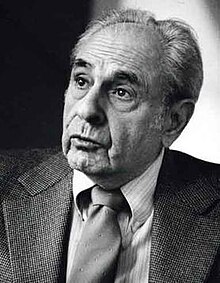Albert Schatz (scientist)
| Albert Schatz | |
|---|---|

Albert Schatz
|
|
| Born | Albert Israel Schatz 2 February 1920 Norwich, Connecticut |
| Died | 17 January 2005 (aged 84) Philadelphia, USA |
| Residence | USA |
| Citizenship | USA |
| Fields |
microbiology science education |
| Institutions |
Brooklyn College National Agricultural College in Doylestown University of Chile Washington University Temple University |
| Alma mater | Rutgers University |
| Known for | discoverer of streptomycin |
| Notable awards | 1994 Rutgers University Medal |
| Spouse | Vivian Schatz (née Rosenfeld, married 1945) |
| Children | Linda Schatz Diane Klein |
Albert Israel Schatz (2 February 1920 – 17 January 2005) was an American microbiologist and science educator, best known as a codiscoverer of the antibiotic streptomycin. Schatz graduated from Rutgers University in 1942 with a bachelor's degree in soil microbiology, and received his doctorate from Rutgers in 1945.
In 1943, as a 23-year-old postgraduate research assistant working in the university's soil microbiology laboratory under the direction of Selman Waksman, Schatz volunteered to search for soil-born microorganisms that would kill or inhibit the growth of penicillin-resistant bacteria including tubercle bacillus, the bacterium that causes tuberculosis (TB). In three and a half months he had isolated two distinct microorganisms excreting a substance (which he named "streptomycin") that stopped the growth of tubercle bacillus and several other penicillin-resistant bacteria in a petri dish.
Schatz was born in Norwich, Connecticut, and raised on a poor, isolated Passaic, New Jersey farm by his Russian Jewish émigré father and English mother. His initial interest in soil microbiology stemmed from his intention to become a farmer. Seeing workers being assaulted by the authorities during the Depression prompted him to lifelong socialism and humanitarianism. He and Vivian Rosenfeld, a student at New Jersey College for Women, were married in March 1945 and they had two daughters, Linda and Diane. The couple were enthusiastic naturalists and environmentalists and they enjoyed the wilds of Vermont. Schatz was interested in the paranormal and alternative medicine (therapeutic touch). He campaigned against the fluoridation of drinking water, argued for a "proteolysis-chelation theory" of tooth decay and proposed a novel theory for the cause of the extinction of the dinosaurs.
A fellow postgraduate student, Doris Ralston, described Schatz as "A poverty-stricken, brilliant student who worked with a burning intensity." He graduated from Rutgers University in 1942 and commenced working as a postgraduate assistant under the supervision of Selman Waksman, who led the soil microbiology department at Rutgers college of agriculture. Waksman had been directing a research program searching for new antibiotic compounds generated by microorganisms in ordinary soil since 1937, and his teams were to discover more than ten such chemicals between 1940 and 1952. After five months, Schatz was conscripted, and worked as a bacteriologist at a military hospital in Florida until he was discharged due to back problems.
...
Wikipedia
